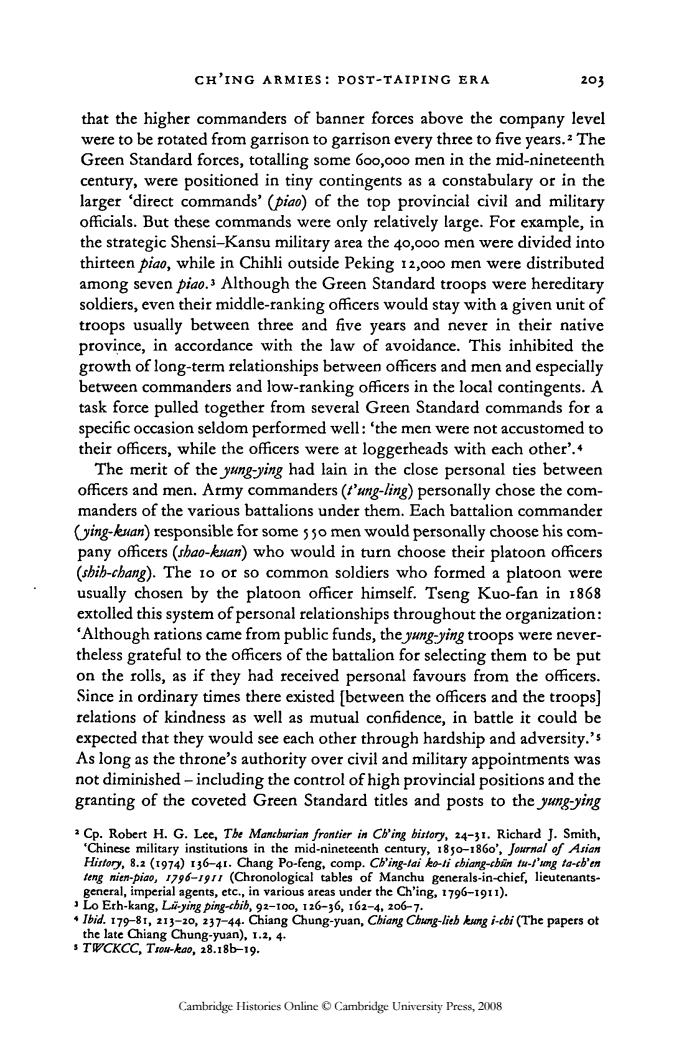正在加载图片...

CH'ING ARMIES:POST-TAIPING ERA 203 that the higher commanders of banner forces above the company level were to be rotated from garrison to garrison every three to five years.2 The Green Standard forces,totalling some 6o0,ooo men in the mid-nineteenth century,were positioned in tiny contingents as a constabulary or in the larger 'direct commands'(piao)of the top provincial civil and military officials.But these commands were only relatively large.For example,in the strategic Shensi-Kansu military area the 40,ooo men were divided into thirteen piao,while in Chihli outside Peking 12,ooo men were distributed among seven piao.3 Although the Green Standard troops were hereditary soldiers,even their middle-ranking officers would stay with a given unit of troops usually between three and five years and never in their native province,in accordance with the law of avoidance.This inhibited the growth of long-term relationships between officers and men and especially between commanders and low-ranking officers in the local contingents.A task force pulled together from several Green Standard commands for a specific occasion seldom performed well:the men were not accustomed to their officers,while the officers were at loggerheads with each other'.+ The merit of the yungying had lain in the close personal ties between officers and men.Army commanders('ung-ling)personally chose the com- manders of the various battalions under them.Each battalion commander (ying-kran)responsible for some sso men would personally choose his com- pany officers (shao-ran)who would in turn choose their platoon officers (shib-chang).The to or so common soldiers who formed a platoon were usually chosen by the platoon officer himself.Tseng Kuo-fan in 1868 extolled this system of personal relationships throughout the organization: 'Although rations came from public funds,the yung-ying troops were never- theless grateful to the officers of the battalion for selecting them to be put on the rolls,as if they had received personal favours from the officers. Since in ordinary times there existed [between the officers and the troops] relations of kindness as well as mutual confidence,in battle it could be expected that they would see each other through hardship and adversity.'s As long as the throne's authority over civil and military appointments was not diminished-including the control of high provincial positions and the granting of the coveted Green Standard titles and posts to the yung-ying a Cp.Robert H.G.Lee,The Mancburian frontier in Cb'ing bistory,24-31.Richard J.Smith, 'Chinese military institutions in the mid-nineteenth century,185o-1860',Journal of Arian History,8.2 (1974)136-41.Chang Po-feng,comp.Ch'ing-tai ko-li cbiang-cbiin tu-I'umng ta-cb'en feng nien-piao,1796-19r (Chronological tables of Manchu generals-in-chief,lieutenants- general,imperial agents,etc.,in various areas under the Ch'ing,1796-1911). Lo Eth-kang,Lii-ying ping-cbib,92-100,126-36,162-4,206-7. Ibid.179-81,213-20,237-44.Chiang Chung-yuan,Chiang Chuong-lieb kung i-cbi (The papers ot the late Chiang Chung-yuan),1.2,4. s TWCKCC,Trou-kao,28.18b-19. Cambridge Histories Online O Cambridge University Press,2008CH'IN G ARMIES: POST-TAIPING ERA 203 that the higher commanders of banner forces above the company level were to be rotated from garrison to garrison every three to five years.2 The Green Standard forces, totalling some 600,000 men in the mid-nineteenth century, were positioned in tiny contingents as a constabulary or in the larger 'direct commands' (piao) of the top provincial civil and military officials. But these commands were only relatively large. For example, in the strategic Shensi-Kansu military area the 40,000 men were divided into thirteen piao, while in Chihli outside Peking 12,000 men were distributed among seven piao.* Although the Green Standard troops were hereditary soldiers, even their middle-ranking officers would stay with a given unit of troops usually between three and five years and never in their native province, in accordance with the law of avoidance. This inhibited the growth of long-term relationships between officers and men and especially between commanders and low-ranking officers in the local contingents. A task force pulled together from several Green Standard commands for a specific occasion seldom performed well: 'the men were not accustomed to their officers, while the officers were at loggerheads with each other'.* The merit of the yung-ying had lain in the close personal ties between officers and men. Army commanders (t'ung-ling) personally chose the commanders of the various battalions under them. Each battalion commander (ying-kuari) responsible for some 550 men would personally choose his company officers (shao-kuan) who would in turn choose their platoon officers {shih-chang). The 10 or so common soldiers who formed a platoon were usually chosen by the platoon officer himself. Tseng Kuo-fan in 1868 extolled this system of personal relationships throughout the organization: 'Although rations came from public funds, theyung-ying troops were nevertheless grateful to the officers of the battalion for selecting them to be put on the rolls, as if they had received personal favours from the officers. Since in ordinary times there existed [between the officers and the troops] relations of kindness as well as mutual confidence, in battle it could be expected that they would see each other through hardship and adversity.'' As long as the throne's authority over civil and military appointments was not diminished - including the control of high provincial positions and the granting of the coveted Green Standard titles and posts to the yung-ying 1 Cp. Robert H. G. Lee, The Manchwian frontier in Ch'ing history, 24-31. Richard J. Smith, 'Chinese military institutions in the mid-nineteenth century, 18 50-1860', Journal of Asian History, 8.2 (1974) 136-41. Chang Po-fcng, comp. Ch'ing-tai ko-ti chiang-cbiin tu-t'ung ta-cb'en teng nien-piao, 1796-1)11 (Chronological tables of Manchu generals-in-chief, lieutenantsgeneral, imperial agents, etc., in various areas under the Ch'ing, 1796-1911). 1 Lo Erh-kang, LM-yingping-cbih, 92-100, 126-36, 162-4, 206-7. 4 Ibid. 179-81, 213-20, 237-44. Chiang Chung-yuan, Chiang Cbtmg-Utb kung i-cbi(The papers ot the late Chiang Chung-yuan), 1.2, 4. ' TWCKCC, Tsou-kao, 28.18D-19. Cambridge Histories Online © Cambridge University Press, 2008